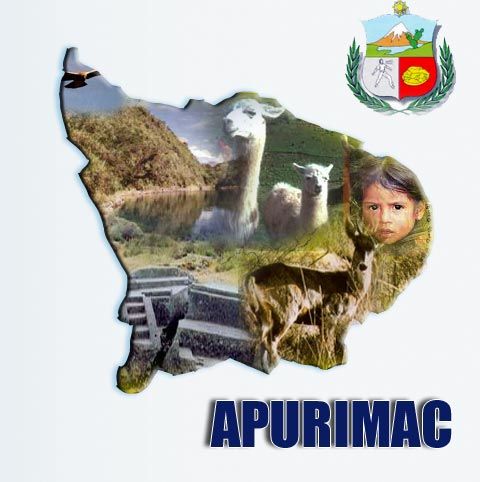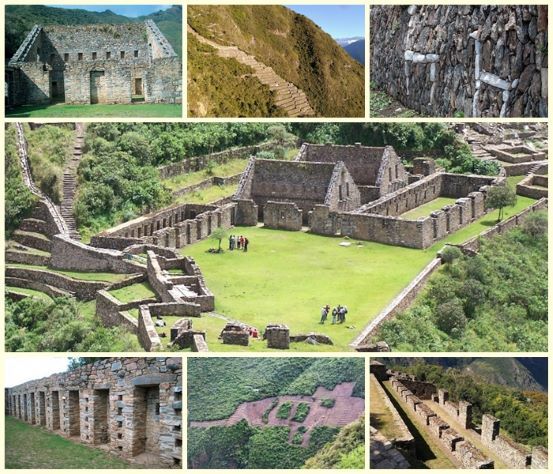The legendary Chanka culture developed in this territory, especially in the current province of Andahuaylas. Notable warriors as well as farmers, they engaged in a bloody fight against the Incas, whom they almost defeated until Pachacútec’s army defeated them. Apurímac was one of the few places where agriculture was perfected, after its inhabitants imposed an effective form of private property on the land.
Location:

choquequirao apurimac 
choquequirao apurimac
The department of Apurimac is located in the southern central region of Peru. The relief of the department, in which the Huaso mountain range stands out, is very rugged because it is located in the most remote peaks of the Andes. 90% of the territory is more than 3,000 meters above sea level.
Territory:
The Apurimac region has an area of 20,895.79 km² (1.6% of the national territory), in which the inhabitant represents 1.7% of the total population of the country.
Its territory is rugged, deep valleys and rugged peaks alternate with high plateaus or peaks and snowy peaks, among the latter we can mention: The Inticancha (5,081mts); The Mallmanya (5,115 meters) and the Cerro Cuche (5,071 meters), in the Aymaraes province and the Ampay (5,223 meters), in the Abancay province.
Political Division:
The capital of the Apurímac region is the city of Abancay.
The region is politically made up of 7 provinces and has a total of 80 districts.
Andahuaylas in Apurímac
The city of Andahuaylas in Apurímac is the capital of the province of the same name, it is one of the 7 provinces that make up the Department of Apurimac. It is also known as the land of clouds (because of the color of the sky at sunset) and the CHANKA culture.
Andahuaylas in Apurímac is located at 2,980 meters above sea level and has a slightly cold climate. In its Plaza de Armas highlights the pool built of a single stone and the Cathedral of San Pedro that was built in the Colonial Era.
Here is a summary of the main attractions that you will find in this province of the Apurimac department, which you will be able to appreciate in more detail in the following pages.
Note: The Province of Andahuaylas in Apurímac has been placed first because the road that connects these towns starting from Ayacucho, passes through Andahuaylas, then Abancay, to later arrive in Cusco, which is the arrival point of many tourists.
Abancay in Apurímac
Abancay is located at an altitude of 2,377 meters above sea level in the southern Peruvian Andes, on the banks of the Mariño River, a tributary of the Pachachaca River. Due to its dry mountains and its warm climate all year round, it is known as “The Valley of Eternal Spring.” Abancay is located at the intersection of 2 important Peruvian highways: the Caminos del Inca highway, an ancient Inca trail between the cities of Nazca and Cusco, and the Via de los Libertadores, connecting Ayacucho and Cusco.
The city encompasses the districts of Abancay and Tamburco. Abancay comes from the Quechua word amánkay, which means lily.
The city of Abancay is located in the Central Andes at coordinates 13º 38 ′ 33 ′ »south latitude and 72º 52 ′ 54 ″ west longitude. It is at 2.378msnm
Weather:
The climate is varied according to the altitude floors. Warm and humid at the bottom of the deep canyons of the Apurímac, Pampas and Pachachaca, temperate and dry in the middle altitudes. Cold and with accentuated atmospheric dryness in the high mountains and very cold in the snowy peaks. The variation in temperature is very significant and increases with altitude. For example, in Antabamba, at 3,636 m.a.s.l. In the month of October, the daytime temperature reaches 25 ° C and at night it drops to 3 ° C and in the month of June, Austral winter, the maximum daytime temperature reaches 20.2 ° CC and at night it drops to 0.6 ° C.
Tourism:
At the tourist level, the department of Apurímac has an interesting range of tourist attractions for the practice of archaeological tourism, among which we can mention:
Archaeological Complex of Curamba – It is located in the province of Andahuaylas. It is an administrative center of Inca origin. In this area, structures such as the Inca Monte stand out, where metallurgical furnaces are located; in addition to the Pyramid of Curamba which is considered an Ushnu.
Sondor Archaeological Complex – This is a ceremonial center of Inca origin that is located in the province of Andahuaylas. In this one, a building known by the name of Muyu Muyu stands out, this is a promontory in which there is a pyramidal structure of eight platforms.
Saywite archaeological site – It is located in the Curahuasi district in Abancay. This occupies an area of approximately 2 hectares in which important samples of Inca lithic art are housed, along with spaces for ritual purposes.
In addition to the above, Apurímac presents attractive sites for those interested in ecological tourism such as:
The Vilcabamba mountain range – Which is located between the regions of Cusco and Apurímac. It is valuable not only for its beauty, but also for the historical richness that it presents and that is manifested in the archaeological legacies that are distributed in its territory.
Nevado de Ampay – This is located in the province of Abancay, this is a natural reservoir of a significant amount of water for human consumption. This is also attractive for those who are interested in the practice of mountaineering.
The department of Apurímac also presents key dates to be visited, among which you can find:
- Abancay Tourist Week – This is a celebration that presents a movable date and that has become a tradition in Abancay in Apurímac and that, as its name suggests, aims to attract many tourists to the area.
- Abancay Carnival – celebration that takes place throughout Abancay in Apurímac. In this, the election of the carnival queen is held, as well as food and dance competitions, among others. The comparsas are also unavoidable on this date.
- Sondor Raymi – Which is also known as the epic Chanka. It takes place on June 18 and 19 and has the participation of descendants of the Chankas who represent the history of this town on a stage.
- Fiesta Mayor Señor de Ánimas – It is a religious celebration that takes place in the district of Chalhuanca every July 31 and that brings together thousands of faithful from the region who move in procession from early hours following the image.
- Reina cañaveral – Tourist festival that takes place in the Chincheros district. This presents different celebration days that are usually held in September. In this, in addition to the election of the reed queen, aquatic competitions are held.
If you travel to Cusco, we recommend you to visit another impressive destinations like the rainbow mountain tour, the humantay lake tour, or the sacred valley tour, which only takes one day. But if you are gonna to stay more days in Perú, other archaeological places you can know will be the machu picchu day tours from cusco.
Apurímac River
The Apurímac River is one of the main rivers of Peru, a tributary of the Ene River that is part of the upper course of the Ucayali River, and in whose basin the most distant source of the Amazon River is born, on the slopes of Nevado Mismi, at 5,597 meters.
Place names
The Apurímac River denomination makes merit of its wealth that in the Inca Quechua language is Apu – Rimac (Talking God). Apu, in Quechua, means “sir.” The Apu Rimac is the “Oracle or Great Talker”, considered the most powerful of the Inca oracles, who spoke through the tremendous rapids of the river.
Geography
Peru is undoubtedly a varied and privileged country and has 85% of the world’s microclimates and therefore a similar percentage of the totality of the world’s flora and fauna, the Andean highlands, the melting of the mountain chain of the Andes, cause the formation of lakes, lagoons and rivers throughout the mountains of Peru, which generates an excellent habitat for the development of the three varieties of trout that exist in Peru: the golden trout, the rainbow trout, and the Brown trout and sardines and the fish that our ancestors, the Incas assumed and still here in Cusco – Peru, is found in some rivers called Jahuaco fish, which have caught fish (trout) weighing 2 to 10 kilos . In the lagoons with spinning lure (butterfly) and fly fishing, however, it is possible to find specimens weighing 500 gr. At 2 kg. Almost in all the mountain rivers, but in some rivers there are still good specimens, as in the Apurímac river, fishing is recommended between the months, from May to October, especially with butterfly using Nos. 1 to 3.
Origin
The Apurímac River has its origin in the Andes mountain range, in the Nevado Mismi mountain (5597 m), between Cusco and Arequipa, 650 kilometers southeast of Lima and 160 km west of the Lake Titicaca basin, being the most distant from the Amazon basin.










